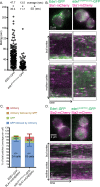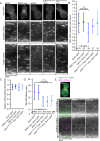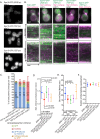Selection and stabilization of endocytic sites by Ede1, a yeast functional homologue of human Eps15
- PMID: 28057762
- PMCID: PMC5328616
- DOI: 10.1091/mbc.E16-06-0391
Selection and stabilization of endocytic sites by Ede1, a yeast functional homologue of human Eps15
Abstract
During clathrin-mediated endocytosis (CME), endocytic-site maturation can be divided into two stages corresponding to the arrival of the early and late proteins at the plasma membrane. The early proteins are required to capture cargo and position the late machinery, which includes proteins involved in actin assembly and membrane scission. However, the mechanism by which early-arriving proteins select and stabilize endocytic sites is not known. Ede1, one of the earliest proteins recruited to endocytic sites, facilitates site initiation and stabilization. Deletion of EDE1 results in fewer CME initiations and defects in the timing of vesicle maturation. Here we made truncation mutants of Ede1 to better understand how different domains contribute to its recruitment to CME sites, site selection, and site maturation. We found that the minimal domains required for efficient Ede1 localization at CME sites are the third EH domain, the proline-rich region, and the coiled-coil region. We also found that many strains expressing ede1 truncations could support a normal rate of site initiation but still had defects in site-maturation timing, indicating separation of Ede1 functions. When expressed in yeast, human Eps15 localized to the plasma membrane, where it recruited late-phase CME proteins and supported productive endocytosis, identifying it as an Ede1 functional homologue.
© 2017 Lu and Drubin. This article is distributed by The American Society for Cell Biology under license from the author(s). Two months after publication it is available to the public under an Attribution–Noncommercial–Share Alike 3.0 Unported Creative Commons License (http://creativecommons.org/licenses/by-nc-sa/3.0).
Figures





Similar articles
-
Condensation of Ede1 promotes the initiation of endocytosis.Elife. 2022 Apr 12;11:e72865. doi: 10.7554/eLife.72865. Elife. 2022. PMID: 35412456 Free PMC article.
-
Casein kinase 1 promotes initiation of clathrin-mediated endocytosis.Dev Cell. 2015 Jan 26;32(2):231-40. doi: 10.1016/j.devcel.2014.11.014. Dev Cell. 2015. PMID: 25625208 Free PMC article.
-
The conserved protein adaptors CALM/AP180 and FCHo1/2 cooperatively recruit Eps15 to promote the initiation of clathrin-mediated endocytosis in yeast.PLoS Biol. 2024 Sep 24;22(9):e3002833. doi: 10.1371/journal.pbio.3002833. eCollection 2024 Sep. PLoS Biol. 2024. PMID: 39316607 Free PMC article.
-
The long life of an endocytic patch that misses AP-2.Curr Genet. 2016 Nov;62(4):765-770. doi: 10.1007/s00294-016-0605-3. Epub 2016 Apr 28. Curr Genet. 2016. PMID: 27126383 Review.
-
Taking apart the endocytic machinery.J Cell Biol. 2008 Mar 24;180(6):1059-60. doi: 10.1083/jcb.200802174. J Cell Biol. 2008. PMID: 18362177 Free PMC article. Review.
Cited by
-
Ubiquitin-driven protein condensation stabilizes clathrin-mediated endocytosis.PNAS Nexus. 2024 Aug 21;3(9):pgae342. doi: 10.1093/pnasnexus/pgae342. eCollection 2024 Sep. PNAS Nexus. 2024. PMID: 39253396 Free PMC article.
-
Condensation of Ede1 promotes the initiation of endocytosis.Elife. 2022 Apr 12;11:e72865. doi: 10.7554/eLife.72865. Elife. 2022. PMID: 35412456 Free PMC article.
-
Roles of the fission yeast UNC-13/Munc13 protein Ync13 in late stages of cytokinesis.Mol Biol Cell. 2018 Sep 15;29(19):2259-2279. doi: 10.1091/mbc.E18-04-0225. Epub 2018 Jul 25. Mol Biol Cell. 2018. PMID: 30044717 Free PMC article.
-
ANTH domains within CALM, HIP1R, and Sla2 recognize ubiquitin internalization signals.Elife. 2021 Nov 25;10:e72583. doi: 10.7554/eLife.72583. Elife. 2021. PMID: 34821552 Free PMC article.
-
Roles of CgEde1 and CgMca in Development and Virulence of Colletotrichum gloeosporioides.Int J Mol Sci. 2024 Mar 3;25(5):2943. doi: 10.3390/ijms25052943. Int J Mol Sci. 2024. PMID: 38474190 Free PMC article.
References
-
- Brach T, Godlee C, Moeller-Hansen I, Boeke D, Kaksonen M. The initiation of clathrin-mediated endocytosis is mechanistically highly flexible. Curr Biol. 2014;24:548–554. - PubMed
MeSH terms
Substances
Grants and funding
LinkOut - more resources
Full Text Sources
Other Literature Sources
Molecular Biology Databases
Research Materials
Miscellaneous

